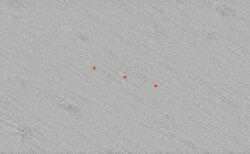Astronomy:2006 QV89
 The region of the sky where astronomers looked for asteroid 2006 QV89.[1] | |
| Discovery[2] | |
|---|---|
| Discovered by | Catalina Sky Survey (703) |
| Discovery date | 29 August 2006 |
| Designations | |
| 2006 QV89 | |
| Minor planet category | |
| Orbital characteristics[3] | |
| Epoch 27 April 2019 (JD 2458600.5) | |
| Uncertainty parameter 0 | |
| Observation arc | 12.9 years |
| |{{{apsis}}}|helion}} | 1.4595 astronomical unit|AU (218,340,000 km) (Q) |
| |{{{apsis}}}|helion}} | 0.92454 AU (138,309,000 km) (q) |
| 1.1920 AU (178,320,000 km) (a) | |
| Eccentricity | 0.22441 (e) |
| Orbital period | 1.30 yr |
| Mean anomaly | 217.85° (M) |
| Inclination | 1.0714° (i) |
| Longitude of ascending node | 166.06° (Ω) |
| 236.72° (ω) | |
| Earth MOID | 10200 km |
| Jupiter MOID | 3.9 AU (580,000,000 km) |
| Physical characteristics | |
| Dimensions |
|
| Absolute magnitude (H) | 25.3[3] |
2006 QV89 (also written 2006 QV89) is an Apollo near-Earth asteroid roughly 30 meters (100 feet) in diameter. It was discovered on 29 August 2006 when the asteroid was about 0.03 AU (4,500,000 km; 2,800,000 mi) from Earth and had a solar elongation of 150 degrees.
Recovery
The asteroid was recovered on 11 August 2019 by the Canada–France–Hawaii Telescope,[5] extending the observation arc from 10 days to 12 years. 2006 QV89 will make a closest approach to Earth on 27 September 2019 at a distance of 0.0463 AU (6,930,000 km; 4,300,000 mi).[3][6] The August 2019 orbit solution will pass about 600000 km further from Earth than the 2006 orbit solution.[7][lower-alpha 1] It was removed from the Sentry Risk Table on 11 August 2019.
Possible Earth impact
2006 QV89 has a low 1.07° orbital inclination with respect to the Ecliptic plane and an Earth-MOID of only 10200 km.[3] Where Earth will be on a given date was known, but given the relatively old and short observation arc (10 days in 2006) it could not be predicted accurately where the asteroid will be on its orbit.[6] Based on the available data, the Sentry Risk Table showed an estimated 1 in 9100 chance of the asteroid impacting Earth on 9 September 2019.[4] The nominal JPL Horizons 9 September 2019 Earth distance was 0.05 AU (7,500,000 km; 4,600,000 mi) with a 3-sigma uncertainty of ± 10 million km.[8] NEODyS also listed the nominal 9 September 2019 Earth distance as 0.05 AU (7,500,000 km; 4,600,000 mi).[9] The European Space Agency listed the odds of impact at a comparable 1 in 7300 on 9 September 2019.[10]
A Monte Carlo simulation using Solex 12 with 1000 clones of the asteroid showed that the asteroid's possible positions overlap Earth.[11] The line of variation (LOV) passed over Antarctica and the southern tip of Argentina .[12]
Impact ruled out
While the position of the asteroid was too uncertain as of July 2019 to recover it, it was known where it would be if it were on a collision course. Based on non-observations from 4 to 5 July 2019, the impact was ruled out on 16 July 2019, using the Very Large Telescope in Chile.[13][14] The detection (or lack thereof) of asteroids by this method may be useful for ruling out other potential collisions.[14]
The asteroid came to opposition (opposite the Sun in the sky) on 28 July 2019 at an apparent magnitude of ~22.[9]
Notes
See also
References
- ↑ "ESO and ESA confirm that asteroid 2006 QV89 will not hit Earth in 2019" (in en). https://www.eso.org/public/announcements/ann19039/. Retrieved 19 July 2019.
- ↑ "MPEC 2006-Q58 : 2006 QV89". IAU Minor Planet Center. 2006-08-30. https://minorplanetcenter.net/mpec/K06/K06Q58.html. Retrieved 2019-03-19. (K06Q89V)
- ↑ 3.0 3.1 3.2 3.3 3.4 "JPL Small-Body Database Browser: (2006 QV89)". Jet Propulsion Laboratory. https://ssd.jpl.nasa.gov/tools/sbdb_lookup.html#/?sstr=2006QV89&view=OPC. Retrieved 2019-03-19.
- ↑ 4.0 4.1 "Earth Impact Risk Summary: 2006 QV89". NASA/JPL Near-Earth Object Program Office. https://cneos.jpl.nasa.gov/sentry/details.html#?des=2006%20QV89. Retrieved 2019-03-19.
- ↑ "Near-Earth asteroid 2006 QV89 not a threat for next century". Science Daily. https://www.sciencedaily.com/releases/2019/08/190813101956.htm. Retrieved 2019-08-15.
- ↑ 6.0 6.1 "2006QV89 Close Approaches". NEODyS (Near Earth Objects – Dynamic Site). https://newton.spacedys.com/neodys/index.php?pc=1.1.8&n=2006QV89. Retrieved 2019-03-19.
- ↑ 2019/2006 orbit comparison (Tony Dunn, 11 August 2019)
- ↑ Go to JPL Horizons. Table Settings: only need "20. Observer range & range-rate" AND "39. Range & range-rate 3-sigmas".
RNG_3sigma = uncertainty range in km. (Soln.date: 2019-May-30 generates RNG_3sigma = 8948856 for 9 September 2019) - ↑ 9.0 9.1 "2006QV89 Ephemerides for July-Sept 2019". NEODyS (Near Earth Objects – Dynamic Site). https://newton.spacedys.com/neodys/index.php?pc=1.1.3.1&n=2006QV89&oc=500&y0=2019&m0=7&d0=4&h0=0&mi0=0&y1=2019&m1=9&d1=30&h1=0&mi1=0&ti=1.0&tiu=days. Retrieved 2019-03-19.
- ↑ "esa Risk List". European Space Agency. http://neo.ssa.esa.int/risk-page. Retrieved 2019-06-06.
- ↑ Solex clones (Peter Thomas, 16 March 2019)
- ↑ Path of risk (Risk Corridor) (Peter Thomas, 15 July 2019)
- ↑ ESA confirms asteroid will miss Earth in 2019 (European Space Agency, 16 July 2019)
- ↑ 14.0 14.1 Hainaut, O. R.; Micheli, M.; Cano, J. L.; Martín, J.; Faggioli, L.; Cennamo, R. (2021). "Elimination of a virtual impactor of 2006 QV89 via deep non-detection". Astronomy & Astrophysics 653: A124. doi:10.1051/0004-6361/202141519. Bibcode: 2021A&A...653A.124H.
External links
- SETI Talk with Franck Marchis and Michael Busch
- 2006 QV89 at NeoDyS-2, Near Earth Objects—Dynamic Site
- Ephemeris · Obs prediction · Orbital info · MOID · Proper elements · Obs info · Close · Physical info · NEOCC
- 2006 QV89 at ESA–space situational awareness
- 2006 QV89 at the JPL Small-Body Database
 |

